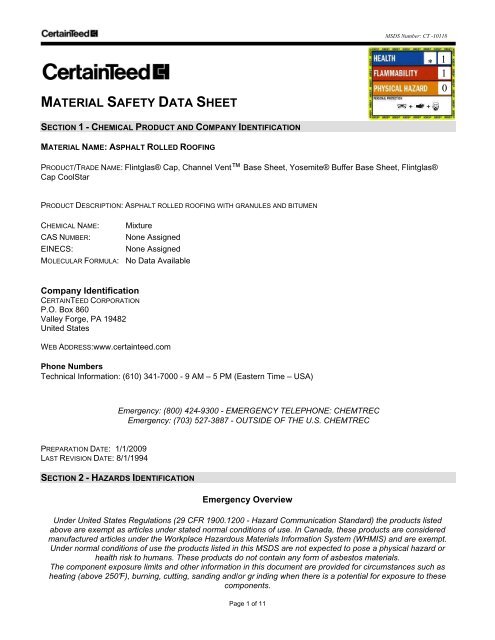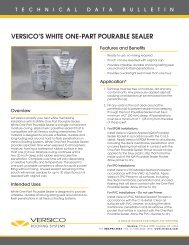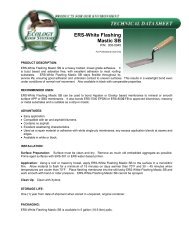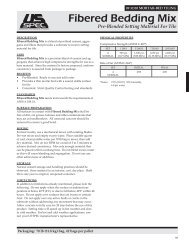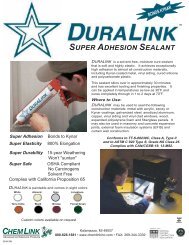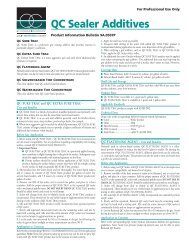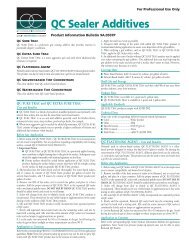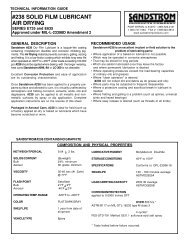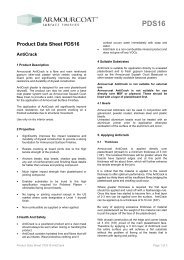FLINTGLAS MS Cap Sheet CoolStar - MSDS - BuildSite.com
FLINTGLAS MS Cap Sheet CoolStar - MSDS - BuildSite.com
FLINTGLAS MS Cap Sheet CoolStar - MSDS - BuildSite.com
Create successful ePaper yourself
Turn your PDF publications into a flip-book with our unique Google optimized e-Paper software.
<strong>MS</strong>DS Number: CT -10118<br />
MATERIAL SAFETY DATA SHEET<br />
*<br />
1<br />
1<br />
0<br />
SECTION 1 - CHEMICAL PRODUCT AND COMPANY IDENTIFICATION<br />
MATERIAL NAME: ASPHALT ROLLED ROOFING<br />
PRODUCT/TRADE NAME: Flintglas® <strong>Cap</strong>, Channel Vent Base <strong>Sheet</strong>, Yosemite® Buffer Base <strong>Sheet</strong>, Flintglas®<br />
<strong>Cap</strong> <strong>CoolStar</strong><br />
PRODUCT DESCRIPTION: ASPHALT ROLLED ROOFING WITH GRANULES AND BITUMEN<br />
CHEMICAL NAME:<br />
CAS NUMBER:<br />
EINECS:<br />
Mixture<br />
None Assigned<br />
None Assigned<br />
MOLECULAR FORMULA: No Data Available<br />
Company Identification<br />
CERTAINTEED CORPORATION<br />
P.O. Box 860<br />
Valley Forge, PA 19482<br />
United States<br />
WEB ADDRESS:www.certainteed.<strong>com</strong><br />
Phone Numbers<br />
Technical Information: (610) 341-7000 - 9 AM – 5 PM (Eastern Time – USA)<br />
Emergency: (800) 424-9300 - EMERGENCY TELEPHONE: CHEMTREC<br />
Emergency: (703) 527-3887 - OUTSIDE OF THE U.S. CHEMTREC<br />
PREPARATION DATE: 1/1/2009<br />
LAST REVISION DATE: 8/1/1994<br />
SECTION 2 - HAZARDS IDENTIFICATION<br />
Emergency Overview<br />
Under United States Regulations (29 CFR 1900.1200 - Hazard Communication Standard) the products listed<br />
above are exempt as articles under stated normal conditions of use. In Canada, these products are considered<br />
manufactured articles under the Workplace Hazardous Materials Information System (WHMIS) and are exempt.<br />
Under normal conditions of use the products listed in this <strong>MS</strong>DS are not expected to pose a physical hazard or<br />
health risk to humans. These products do not contain any form of asbestos materials.<br />
The <strong>com</strong>ponent exposure limits and other information in this document are provided for circumstances such as<br />
heating (above 250°F), burning, cutting, sanding and/or gr inding when there is a potential for exposure to these<br />
<strong>com</strong>ponents.<br />
Page 1 of 11
<strong>MS</strong>DS Number: CT -10118<br />
If heated, this product may cause temporary irritation to the upper respiratory system.<br />
Avoid inhalation as temporary irritation may occur. Due to the abrasive surface of this product, mechanical<br />
irritation/abrasions may occur. Wear appropriate personal protective equipment as described in Section 8.<br />
GHS<br />
Temporary respiratory irritation may occur. Avoid breathing vapors/fumes. Contaminated work clothing should not<br />
be allowed out of the workplace. Wash thoroughly after handling. Wear protective gloves and NIOSH approved<br />
respirator if exposed to dust or if material is heated.<br />
NFPA/HMIS RATINGS:<br />
Health Fire Reactivity<br />
NFPA RATING: 1 1 0<br />
HMIS RATING: 1* 1 0<br />
Degree of Hazard<br />
0 - Minimal (Insignificant)<br />
1 - Slight<br />
2 - Moderate<br />
3 - Serious (High)<br />
4 - Severe (Extreme)<br />
* - Chronic Health Effect(s)<br />
PHYSICAL FORM: Solid<br />
COLOR: Black<br />
ODOR: Mild petroleum odor<br />
HAZARDS: Mild/Slight Irritant; Mechanical Irritant<br />
ROUTE OF ENTRY: Inhalation<br />
MEDICAL CONDITIONS AGGRAVATED BY EXPOSURE: Pre-existing lung conditions which may be aggravated if<br />
fumes/dusts are inhaled.<br />
POTENTIAL HEALTH EFFECTS: Under normal conditions of use these products are not expected to cause a physical<br />
hazard or health risk to humans.<br />
INHALATION:<br />
ACUTE (IMMEDIATE): Temporary irritation of nose and throat may occur.<br />
CHRONIC (DELAYED): This product contains crystalline silica which is listed by IARC as a suspect carcinogen.<br />
Silicosis (pulmonary fibrosis or severe lung scarring) may occur if exposed to high levels or repeated encounters<br />
with dust. Exposure to airborne particles that exceed the limits listed may cause lung cancer.<br />
This product also contains petroleum asphalt. If heated, there is limited evidence that derivatives of asphalt fumes<br />
may cause carcinogenic effects in animals. There is inadequate evidence to support that asphalt fumes alone are<br />
carcinogenic to humans. This product contains fiber glass fibers which are bound in the final product. Under normal<br />
conditions of use there is little chance of release in most emergency situations.<br />
Page 2 of 11
<strong>MS</strong>DS Number: CT -10118<br />
SKIN:<br />
ACUTE (IMMEDIATE): Mechanical irritation of the skin/skin abrasion may occur characterized by itching or redness.<br />
Drying of skin and dermatitis may occur following prolonged exposures.<br />
CHRONIC (DELAYED): No data available<br />
EYE:<br />
ACUTE (IMMEDIATE): Mechanical irritation of the eye/eye abrasion may occur characterized by itching or redness.<br />
CHRONIC (DELAYED): No data available<br />
INGESTION:<br />
ACUTE (IMMEDIATE): Ingestion of this product is unlikely.<br />
CHRONIC (DELAYED): No data available<br />
MUTAGENIC EFFECTS: No information available for the product.<br />
CARCINOGENIC EFFECTS: When used under normal conditions, this product is not considered a carcinogen.<br />
This product contains petroleum asphalt. Asphalt fumes arise from hot asphalt. Asphalt fumes (CAS # 8052-42-4):<br />
In 1985/87, IARC (International Agency for Research on Cancer) concluded the following: (a) Bitumens are not<br />
classifiable as to their carcinogenicity to humans (Group 3). (b) Extracts of steam- and air-refined bitumens are<br />
possibly carcinogenic to humans (Group 2B). IARC found that evidence for carcinogenicity from animal studies<br />
was: inadequate for undiluted air-refined bitumens; limited for steam-refined and cracking residue bitumens;<br />
sufficient for extracts of steam-refined and air-refined bitumen. IARC found that human evidence for carcinogenicity<br />
of asphalt fumes was inadequate. Studies of roofers indicated an excess of cancers; however, IARC concluded<br />
that, since roofers may be exposed also to coal-tar pitches and other materials, "the excess cancer risk cannot be<br />
attributed specifically to bitumens." In 1994, a published review of 20 epidemiology studies of asphalt workers and<br />
roofers agreed with IARC, that current human evidence is inadequate for the carcinogenicity of asphalt fumes in<br />
humans. Trace amounts of polynuclear aromatic hydrocarbons (PAHs) may be present in some asphalts and can<br />
be released upon excessive heating, which results in thermal cracking of the asphalt <strong>com</strong>pounds. Some of these<br />
PAHs have been identified as having the potential to induce carcinogenic and reproductive health effects.<br />
This product contains crystalline silica. IARC Monographs on Evaluation of Carcinogenic Risk of Chemicals to<br />
Humans (Monograph 68, 1997) concludes that there is sufficient evidence for the carcinogenicity of crystalline to<br />
humans, IARC (Group I). Crystalline Silica is classified as a Known Carcinogen according to the NTP.<br />
This product contains glass wool insulation fibers. Following a thorough review of all the medical-scientific data<br />
available at a meeting in October 2001, the IARC panel lowered the classification for glass wool insulation fibers<br />
from a Group 2B classification ("possibly carcinogenic to humans") to a Group 3 classification ("not classifiable as<br />
to carcinogenicity to humans"). IARC said that there is "no evidence of increased risks of lung cancer or of<br />
mesothelioma from occupational exposures during manufacturing of these materials, and inadequate evidence over<br />
all of any cancer risk."<br />
REPRODUCTIVE EFFECTS: No information available for the product.<br />
OTHER HEALTH EFFECTS: None<br />
See Section 12 for Ecological Information<br />
SECTION 3 - COMPOSITION/INFORMATION ON INGREDIENTS<br />
Composition/Information on Ingredients<br />
Product(s) Containing<br />
Component<br />
Chemical<br />
Name<br />
CAS %(weight) UN;EINICS<br />
LD50/<br />
LC50<br />
EU<br />
OSHA<br />
PEL/TWA<br />
ACGIH<br />
TLV/TWA<br />
NIOSH<br />
REL<br />
Flintglas® <strong>Cap</strong>, Channel<br />
Asphalt<br />
8052-42-<br />
4<br />
20% TO<br />
40%<br />
NA1999;<br />
232-490-9<br />
NDA NDA None 0.5 mg/m3<br />
5<br />
mg/m3<br />
Page 3 of 11
<strong>MS</strong>DS Number: CT -10118<br />
Vent Base <strong>Sheet</strong>,<br />
Yosemite, Flintglas <strong>Cap</strong><br />
<strong>CoolStar</strong> contains:<br />
Flintglas® <strong>Cap</strong>, Channel<br />
Vent Base <strong>Sheet</strong>,<br />
Yosemite, Flintglas <strong>Cap</strong><br />
<strong>CoolStar</strong> contains:<br />
Silica,<br />
crystalline -<br />
quartz<br />
14808-<br />
60-7<br />
20% TO<br />
40%<br />
238-878-4 NDA NDA<br />
10 mg/m3<br />
(% SiO2 + 2)<br />
0.025<br />
mg/m3<br />
0.05<br />
mg/m3<br />
Flintglas® <strong>Cap</strong>, Channel<br />
Vent Base <strong>Sheet</strong>,<br />
Yosemite, Flintglas <strong>Cap</strong><br />
<strong>CoolStar</strong> contains:<br />
Calcium<br />
Carbonate<br />
1317-65-<br />
3<br />
5% TO<br />
25%<br />
215-279-6 NDA NDA 15 mg/m3 None<br />
10<br />
mg/m3<br />
Flintglas® <strong>Cap</strong>, Channel<br />
Vent Base <strong>Sheet</strong>,<br />
Yosemite, Flintglas <strong>Cap</strong><br />
<strong>CoolStar</strong> contains:<br />
Fibrous glass<br />
65997-<br />
17-3<br />
78% TO<br />
97%<br />
266-046-0 NDA NDA<br />
1f/cc<br />
(continuous<br />
filament<br />
glass fibers)<br />
1f/cc<br />
(respirable<br />
fibers)<br />
5<br />
mg/m3<br />
(total<br />
dust)<br />
Flintglas <strong>Cap</strong> <strong>CoolStar</strong><br />
contains:<br />
<strong>CoolStar</strong><br />
Coating<br />
NDA<br />
0% TO<br />
10%<br />
NDA NDA NDA None None None<br />
Under United States Regulations (29 CFR 1900.1200 - Hazard Communication Standard) the products listed<br />
above are exempt as articles under stated normal conditions of use. In Canada, these products are considered<br />
manufactured articles under the Workplace Hazardous Materials Information System (WHMIS) and are exempt.<br />
See Section 11 for Toxicological Information<br />
SECTION 4 - FIRST AID MEASURES<br />
INHALATION: Remove to fresh air, apply artificial respiration and/or oxygen if necessary and get medical attention.<br />
SKIN: Removed contaminated clothing and wash exposed skin with soap and water. If irritation develops or persists,<br />
seek medical attention.<br />
EYE: If foreign matter enters eyes, immediately flush with large amounts of water for at least 15 minutes or until<br />
irritation subsides. If irritation develops, or persists, seek medical attention.<br />
INGESTION: Consult a physician if unusual reaction is noted. Product is not intended nor is it likely to be ingested or<br />
eaten.<br />
See Section 2 for Potential Health Effects<br />
SECTION 5 - FIRE FIGHTING MEASURES<br />
SUITABLE EXTINGUISHING MEDIA: Use water, foam, CO2 or dry chemical extinguishers to contain fire.<br />
UNSUITABLE EXTINGUISHING MEDIA: No data available<br />
FIREFIGHTING PROCEDURES: Fire fighters should avoid inhaling any <strong>com</strong>bustion products.<br />
Firefighters should wear full-face, self contained breathing apparatus and impervious protective clothing to avoid<br />
smoke inhalation and lack of oxygen.<br />
UNUSUAL FIRE AND EXPLOSION HAZARDS: Burning of this product will produce thick black smoke.<br />
HAZARDOUS COMBUSTION PRODUCTS: If burned, the materials could release toxic fumes and smoke.<br />
In<strong>com</strong>plete thermal oxidation can produce hydrogen cyanide, carbon monoxide, carbon dioxide, ammonia,<br />
Page 4 of 11
<strong>MS</strong>DS Number: CT -10118<br />
formaldehyde and other low molecular weight hydrocarbons and oxides or sulfur, nitrogen, calcium and<br />
magnesium.<br />
FLASH POINT: NA<br />
FLASH POINT TEST TYPE: N/A<br />
EXPLOSION LIMITS<br />
UPPER: N/A LOWER: N/A<br />
SECTION 6 - ACCIDENTAL RELEASE MEASURES<br />
PERSONAL PRECAUTIONS: Not applicable<br />
EMERGENCY PROCEDURES: Not applicable<br />
CONTAINMENT/CLEAN-UP MEASURES: Pick up large pieces. Vacuum dust. If sweeping is necessary, use a dust<br />
suppressant such as water. These procedures will help to minimize potential exposures. Scoop up material and put<br />
into a suitable container for disposal as a non-hazardous waste.<br />
SECTION 7 - HANDLING AND STORAGE<br />
HANDLING: Do not breathe dusts or fumes generated from cutting or heating this material. Keep this product away<br />
from heat, sparks, or open flame. Use this product with adequate ventilation. Always wash work clothes separately<br />
from other clothing. Wash thoroughly after handling. Use personal protective equipment as described in Section 8.<br />
STORAGE: Store indoors in a cool, dry, well-ventilated area. Do not handle or store near an open flame, heat or<br />
other sources of ignition.<br />
SECTION 8 - EXPOSURE CONTROLS/PERSONAL PROTECTION<br />
PPE:<br />
RESPIRATORY PROTECTION: Respiratory protection is not normally required. Use a NIOSH approved/certified<br />
respiratory when the exposure limits are exceeded. Use a particulate filter respirator for particulate concentrations<br />
exceeding the Occupational Exposure Limit.<br />
EYE/FACE PROTECTION: Safety glasses with side shields should be worn at a minimum.<br />
SKIN/BODY PROTECTION: Leather or cotton gloves may be worn to prevent skin contact and irritation. Normal work<br />
clothing (long sleeved shirts and long pants) is re<strong>com</strong>mended.<br />
GENERAL INDUSTRIAL HYGIENE CONSIDERATIONS: Use good industrial hygiene practices in handling this material.<br />
Availability of eye wash fountains are re<strong>com</strong>mended.<br />
ENGINEERING MEASURES/CONTROLS: No special ventilation systems are required under normal conditions of use.<br />
LISTED EXPOSURE LIMITS:<br />
US State California<br />
• Asphalt (8052-42-4): PELs: (5 mg/m3 PEL)<br />
• Silica, crystalline - quartz (14808-60-7): PELs: (1.0 fiber/cc PEL; 0.5 mg/m3 PEL (respirable dust))<br />
United States - ACGIH<br />
• Asphalt (8052-42-4): TWAs: (0.5 mg/m3 TWA (inhalable fraction, as benzene-soluble aerosol)) | Carcinogens: (A4 - Not Classifiable<br />
as a Human Carcinogen (as benzene soluble aerosol)) | TLV Basis - Critical Effects: (irritation (as benzene-soluble aerosol))<br />
Page 5 of 11
<strong>MS</strong>DS Number: CT -10118<br />
• Silica, crystalline - quartz (14808-60-7): TLVs: (0.025 mg/m3 TWA (respirable fraction); A2 - suspected human carcinogen; TLV<br />
• Fibrous Glass (65997-17-3): TWAs: (1f/cc (Synthetic Vitreous Fibers – continuous filament glass fibers))<br />
United States – OSHA<br />
• Calcium carbonate (1317-65-3): TWAs: (15 mg/m3 TWA (total dust); 5 mg/m3 TWA (respirable fraction)) | TWAs: (15 mg/m3 TWA<br />
(total dust); 5 mg/m3 TWA (respirable fraction))<br />
• Silica, crystalline - quartz (14808-60-7): Mineral Dusts: (((250)/(%SiO2 + 5) mppcf TWA (respirable)); ((10 mg/m3)/(%SiO2 + 2)<br />
mppcf TWA (respirable)); ((30 mg/m3)/(%SiO2 + 2) mppcf TWA (Total Dust))) | TWAs: (0.1 mg/m3 TWA (respirable dust))<br />
• Fibrous Glass (65997-17-3): TWA: (15 mg/m3 (total nuisance dust)); (5 mg/m3 (respirable nuisance dust)) NAIMA PEL: 1f/cc<br />
(continuous filament glass fibers)<br />
United States - NIOSH<br />
• Asphalt (8052-42-4): Ceiling Limits: (5 mg/m3 Ceiling (15 min, fumes))<br />
• Calcium carbonate (1317-65-3): TWAs: (10 mg/m3 TWA (total dust); 5 mg/m3 TWA (respirable dust)) |<br />
• Silica, crystalline - quartz (14808-60-7): TWAs: (0.05 mg/m3 TWA (respirable dust)) |<br />
• Fibrous Glass (65997-17-3): REL/TWA: (5 mg/m3 (total glass dust)); (3f/cc (respirable fibers))<br />
Canada – British Columbia<br />
• Fibrous Glass (65997-17-3): 1 fiber/cm3 TWA (fibers longer than 5 µm, with an aspect ratio of equal to/greater than 3:1) (related to Glass<br />
wool fibers)<br />
Canada – Manitoba<br />
• Fibrous Glass (65997-17-3): 1 fiber/cm3 TWA (respirable fibers, length >5 µm, aspect ratio >=3:1, as determined by the membrane filter<br />
method at 400-450X magnification [4-mm objective], using phase-contrast illumination) (related to Glass wool fibers)<br />
Canada – New Brunswick<br />
• Fibrous Glass (65997-17-3): 1 fibre/cm3 TWA (fibers longer than 5 µm with a diameter less than 3 µm, aspect ratio greater than 5:1) (related<br />
to Glass wool fibers)<br />
Canada – Northwest Territories<br />
• Fibrous Glass (65997-17-3): 3 fibres/cm3 TWA (with a diameter 10 µm); 5 mg/m3 TWA (total mass) (related to<br />
Mineral wool fiber)<br />
Canada – Nova Scotia<br />
• Fibrous Glass (65997-17-3): 1 fiber/cm3 TWA (respirable fibers, length >5 µm, aspect ratio >=3:1, as determined by the membrane filter<br />
method at 400-450X magnification [4-mm objective], using phase-contrast illumination) (related to Glass wool fibers)<br />
Canada – Nunavut<br />
• Fibrous Glass (65997-17-3): 3 fibre/cm3 TWA (with a diameter =10 µm); 5 mg/m3 TWA (total mass) (related to<br />
Mineral wool fiber)<br />
Canada – Ontario<br />
• Fibrous Glass (65997-17-3): 1 fibres/cm3 TWAEV (respirable, length>5 microns, aspect ratio>= 3.1) (related to Glass wool fibers)<br />
Canada – Quebec<br />
• Fibrous Glass (65997-17-3): 2 fibres/cm3 TWAEV (respirable) (related to Insulation wool fibers, glass wool)<br />
Canada – Yukon<br />
• Fibrous Glass (65997-17-3): 30 mppcf TWA; 10 mg/m3 TWA (respirable mass) (related to Mineral wool fiber)<br />
SECTION 9 - PHYSICAL AND CHEMICAL PROPERTIES<br />
PHYSICAL FORM: Solid<br />
APPEARANCE/DESCRIPTION: Asphalt roofing rolls.<br />
COLOR: Black<br />
TASTE: No data available<br />
ODOR: Mild Petroleum odor<br />
ODOR THRESHOLD: NDA<br />
BOILING POINT: NDA VAPOR PRESSURE: NDA<br />
Page 6 of 11
<strong>MS</strong>DS Number: CT -10118<br />
MELTING POINT/FREEZING<br />
POINT:<br />
= NDA VAPOR DENSITY: NDA<br />
SPECIFIC GRAVITY: = NDA EVAPORATION RATE: NDA<br />
DENSITY: = NDA VOC (WT.): NDA<br />
BULK DENSITY: NDA VOC (VOL.): NDA<br />
WATER SOLUBILITY: Insoluble VOLATILES (WT.): NDA<br />
SOLVENT SOLUBILITY: NDA VOLATILES (VOL.): NDA<br />
VISCOSITY: @ FLASH POINT: NDA<br />
HALF-LIFE: NDA FLASH POINT TEST TYPE: NDA<br />
OCTANOL/WATER PARTITION<br />
COEFFICIENT:<br />
NDA UEL: NDA<br />
COEFFICIENT OF WATER/OIL<br />
DISTRIBUTION:<br />
NDA LEL: NDA<br />
BIOACCUMULATION FACTOR: NDA AUTOIGNITION: NDA<br />
PH:<br />
NDA<br />
SECTION 10 - STABILITY AND REACTIVITY<br />
STABILITY: Stable under normal conditions.<br />
HAZARDOUS POLYMERIZATION: Hazardous polymerization will not occur.<br />
CONDITIONS TO AVOID: Keep away from heat, ignition sources and in<strong>com</strong>patible materials.<br />
INCOMPATIBLE MATERIALS: This product will react with strong oxidizing agents, reducing agents, strong acids and<br />
alkalies.<br />
HAZARDOUS DECOMPOSITION PRODUCTS: Upon de<strong>com</strong>position this product may emit hydrogen sulfide,<br />
formaldehyde, hydrogen cyanide, carbon dioxide, carbon monoxide and other low molecular weight hydrocarbons<br />
and oxides of sulfur, nitrogen, calcium and magnesium.<br />
SECTION 11 - TOXICOLOGICAL INFORMATION<br />
This product has not been tested as a separate entity. Therefore, the hazards must be evaluated on the basis of<br />
the individual ingredients, and those hazards must be assumed to be additive in the absence of <strong>com</strong>plete<br />
information. The hazards described in this document have been evaluated on a threshold of 1.0% for all hazardous<br />
ingredients and 0.1% for all carcinogens, mutagens, reproductive hazards and respiratory sensitizers.<br />
ACUTE TOXICITY: Temporary irritation may be observed in the upper respiratory system, eyes, and skin. Inhalation<br />
of dusts/fumes from this product may cause a scratchy throat, congestion, and slight coughing.<br />
CARCINOGENIC EFFECTS: When used under normal conditions, this product is not considered a carcinogen.<br />
Page 7 of 11
<strong>MS</strong>DS Number: CT -10118<br />
COMPONENT CARCINOGENICITY:<br />
This product contains petroleum asphalt. If heated, there is limited evidence that derivatives of asphalt fumes may<br />
cause carcinogenic effects in animals. There is inadequate evidence to support that asphalt fumes alone are<br />
carcinogenic to humans.<br />
Asphalt Fumes (8052-42-4):<br />
ACGIH:<br />
A4 - Not Classifiable as a Human Carcinogen (as benzene soluble aerosol)<br />
IARC: Group 3 - Not Classifiable (IARC Supplement 7 [1987], Monograph 35 [1985])<br />
NIOSH:<br />
Potential occupational carcinogen.<br />
This product contains crystalline silica. Crystalline silica is considered a carcinogen by IARC as well as NTP.<br />
Crystalline Silica (14808-60-7):<br />
NTP:<br />
IARC:<br />
Reasonably Anticipated to be a human carcinogen (1992; Sixth Annual Report on Carcinogens)<br />
Group 2A – Limited Evidence of human carcinogenicity (IARC Monographs on Evaluation of<br />
Carcinogenic Risk of Chemicals to Humans [volume 42, 1987]))<br />
ACGIH:<br />
A2 – Suspected human carcinogen<br />
NIOSH:<br />
Potential occupational carcinogen.<br />
This product contains glass wool insulation fibers. Following a thorough review of all the medical-scientific data<br />
available at a meeting in October 2001, the IARC panel lowered the classification for glass wool insulation fibers<br />
from a Group 2B classification ("possibly carcinogenic to humans") to a Group 3 classification ("not classifiable as<br />
to carcinogenicity to humans"). IARC said that there is "no evidence of increased risks of lung cancer or of<br />
mesothelioma from occupational exposures during manufacturing of these materials, and inadequate evidence over<br />
all of any cancer risk."<br />
Fiberglass mat, which is made from either: Continuous filament fiber glass (encapsulated) or Fibrous glass (65997-17-3):<br />
ACGIH:<br />
NTP:<br />
IARC:<br />
A3 - Confirmed animal carcinogen with unknown relevance to humans (related to Glass wool fibers)<br />
Reasonably Anticipated To Be A Carcinogen (respirable size) (related to Glass wool) (Possible Select<br />
Carcinogen)<br />
Monograph 81 [2002] (listed under Man-made mineral fibers), Monograph 43 [1988] (related to<br />
Insulation glass wool) (Group 3 (not classifiable))<br />
SECTION 12 - ECOLOGICAL INFORMATION<br />
PRODUCT INFORMATION: This product has not been tested. Based on information related to all raw materials in the<br />
finished product it is not expected to harm ecosystems through its applied use.<br />
ECOLOGICAL FATE: No information available for the product.<br />
Page 8 of 11
<strong>MS</strong>DS Number: CT -10118<br />
PERSISTANCE/DEGRADABLITY: No information available for the product.<br />
SECTION 13 - DISPOSAL CONSIDERATIONS<br />
PRODUCT: This product, as supplied, is not regulated as a hazardous waste by the U.S. Environmental Protection<br />
Agency (EPA) under Resource Conservation and Recovery Act (RCRA) regulations. Comply with state and local<br />
regulations for disposal. If you are unsure of the regulations, contact your local public health department, or the<br />
local office of the EPA.<br />
DISPOSAL: Dispose of waste material according to local, state, federal, and provincial environmental regulations.<br />
SECTION 14 - TRANSPORTATION INFORMATION<br />
U.S. DOT 49 CFR 172.101:<br />
SHIPPING NAME: Not Regulated for Transportation<br />
TDG - CANADA - TRANSPORT OF DANGEROUS GOODS:<br />
SHIPPING NAME: Not Classified as a Dangerous Good for Transport<br />
SECTION 15 - REGULATORY INFORMATION<br />
SARA HAZARD CLASSIFICATIONS:<br />
Acute Health: Yes Chronic Health: Yes Fire: No Pressure: No Reactive: No<br />
US FEDERAL:<br />
GENERAL PRODUCT INFORMATION:<br />
Components of this product have been checked against the non-confidential TSCA inventory by<br />
CAS Registry Number. Components not identified on this non-confidential inventory are either<br />
exempt from listing (i.e. polymers, hydrates) or are listed on the confidential inventory as declared<br />
by the supplier.<br />
TSCA (Toxic Substances Control Act) - Section 8(a) - Inventory Update Rule - Partially Exempt Substances<br />
• Asphalt (8052-42-4) 20 to 40% Partially exempt chemical substance termed 'Petroleum Process Stream'<br />
• Calcium carbonate (1317-65-3) 5 to 25% Partially exempt chemical substance under 40 CFR 710.46(b)(2)<br />
• Silica Crystalline<br />
Quartz<br />
(14808-60-7) 20% to 40%<br />
CERCLA:<br />
This material does not contain chemicals required to be identified under CERCLA (40 CFR 302.4).<br />
STATE REGULATIONS:<br />
COMPONENT ANALYSIS - STATE:<br />
The following <strong>com</strong>ponents appear on one or more of the following state hazardous substances<br />
lists:<br />
Component CAS # CA MA MN NJ PA RI<br />
Petroleum Asphalt (fumes) 8052-42-4 Yes Yes Yes Yes Yes Yes<br />
Calcium Carbonate 1317-65-3 No Yes Yes No Yes Yes<br />
Silica Crystalline Quartz 14808-60-7 Yes Yes Yes Yes Yes Yes<br />
Fiberglass mat, which is made from either:<br />
Continuous filament fiber glass (encapsulated)<br />
or Fibrous glass (¹related to Mineral wool fiber)<br />
65997-17-3 Yes Yes Yes No Yes Yes<br />
Page 9 of 11
<strong>MS</strong>DS Number: CT -10118<br />
CALIFORNIA SAFE DRINKING WATER AND TOXICS ENFORCEMENT ACT (PROPOSITION 65):<br />
The following statement(s) are provided under the California Safe Drinking Water and Toxic<br />
Enforcement Act of 1986 (Proposition 65):<br />
WARNING!<br />
This product contains a chemical known to the state of California to cause cancer and birth defects,<br />
or other reproductive harm.<br />
CANADIAN WHMIS INFORMATION:<br />
GENERAL PRODUCT INFORMATION:<br />
In Canada, these products are considered manufactured articles under the Workplace Hazardous Materials<br />
Information System (WHMIS) and are exempt.<br />
COMPONENT ANALYSIS - WHMIS IDL:<br />
The following <strong>com</strong>ponents are identified under the Canadian Hazardous Products Act Ingredient<br />
Disclosure List:<br />
• Silica, crystalline -<br />
(14808-60-7) 20 to 40% 1 % (English Item 1406, French Item 1491)<br />
quartz<br />
ADDITIONAL REGULATORY INFORMATION:<br />
GENERAL PRODUCT INFORMATION:<br />
No information available for the product.<br />
COMPONENT ANALYSIS – INVENTORY:<br />
Component CAS # TSCA DSL EINECS<br />
Asphalt 8052-42-4 Yes Yes Yes<br />
Silica Crystalline Quartz 14808-60-7 Yes Yes Yes<br />
Calcium carbonate 1317-65-3 Yes No Yes<br />
Fiberglass mat, which is made from either: Continuous<br />
filament fiber glass (encapsulated) or Fibrous glass<br />
65997-17-3 Yes Yes Yes<br />
Aluminum Hydroxide (<strong>CoolStar</strong> Coating) 21645-51-2 Yes Yes Yes<br />
Titanium Dioxide (<strong>CoolStar</strong> Coating) 13463-67-7 Yes Yes Yes<br />
SECTION 16 - OTHER INFORMATION<br />
PREPARATION DATE: 1/1/2009<br />
LAST REVISION DATE: 8/1/1994<br />
DISCLAIMER: Reasonable care has been taken in the preparation of this information, but the supplier gives no<br />
warranty of merchantability or of fitness for a particular purpose. Any product purchased is sold on the assumption<br />
the purchaser will make his own tests to determine the quality and suitability of the product. Supplier expressly<br />
disclaims any and all liability for incidental and/or consequential property damage arising out of the use of this<br />
product. No information provided shall be deemed to be a re<strong>com</strong>mendation to use any product in conflict with any<br />
existing patent rights. Read the Material Safety Data <strong>Sheet</strong> before handling product.<br />
Page 10 of 11
<strong>MS</strong>DS Number: CT -10118<br />
For reference to the acronyms/definitions used in this <strong>MS</strong>DS please visit www.certainteed.<strong>com</strong>.<br />
<strong>MS</strong>DS HISTORY:<br />
<strong>MS</strong>DS REVISION SUMMARY:<br />
Date <strong>MS</strong>DS No. Changes<br />
1/1/2009 CT-10118<br />
• <strong>MS</strong>DS format change (new ANSI Z400.2004 & GHS v .2007<br />
format)<br />
• Section 2 – GHS (v. 2007) Classifications<br />
This is the end of <strong>MS</strong>DS # CT-10118<br />
Page 11 of 11


